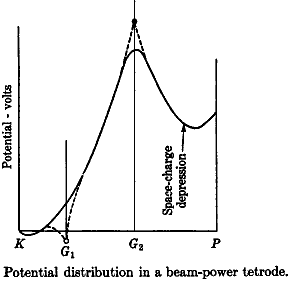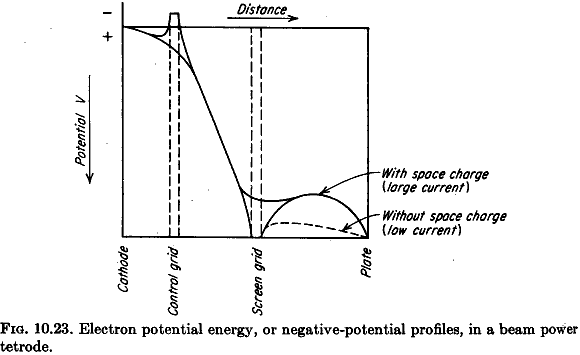Beam Power Tetrode
Beam Power Tetrode

From time to time the question is made why the base diagram of a Beam Power Tetrode is similar to that of a Pentode, displaying 5 electron handling elements.
Even the manufacturers literature is sometimes suspected to err, and even attempts are made to have our tube pages in RMorg "corrected".
There are some good explanations of that design, but they are hidden in long treatise.
Here a recapitulation:
The Beam Power Tetrode has 5 elements, but the beam confining electrodes are not a grid. In particular RCA insisted in the name tetrode to distinguish it from the pentode patented by Philips. The beam power tetrode acts almost like a pentode and both use the same symbol.
To thank the Author because you find the post helpful or well done.

It is interesting to add that RC-15 tube manual shows a base diagram that includes the the beam deflection elements and describes the 6V6GT as a Beam Power Amplifier , but later editions, such as the RC-17, refer to the same tube with the same name but omit the base diagram that includes the deflection elements, using the common pentode base with supresor grid and ommiting the designation tetrode or pentode alltogether. (both in their Spanish versions, published by ARBO editores, Buenos Aires)
Sylvania tube manual also skips the tetrode/pentode issue by calling the 6V6 "Power amplifier"
What really added wood to the fire is the fact the defelection elements are connected to the cathode inside the tube, same way it occurs with the supressor grid although they are two different things.
Mario
To thank the Author because you find the post helpful or well done.
Beam Power Tubes













To thank the Author because you find the post helpful or well done.
The beam tetrode Knee
Dear Dr. Rudolph,
Thank for the excelent overview of Pentode vs Tetrode operation! The material from various sources sheds new light in my understanding of curve behaviour at the knee.
One key point that this clarified for me is that the purpose of the beam is to retain high electron density on the way to the plate, as opposed to concentrate a space charge that had become rarified before the beam plates.
This realization explains to me the slight tetrode-like dip that is seen in most beam tetrode curves at low current. At low current, there is not enough beam current for effective secondary emission repulsion.
In a recent restoration effort of a Sonora TE-38 phonograph, I thought to replace a 70L7 beam tetrode with a 117L7. As the link shows, I learned that there is a lot of variation of beam tetrode design between these two beam tetrodes near the knee, where plate voltage is low.
The design of behaviour at the knee became most important for Beam tetrodes meant for application in American low voltage AC/DC radios. The B+ in these radios is only around 110V. It took several beam tetrode design iterations for knee behaviour to be optimized at low plate voltage, as seen in a 50C5.
At the end of the tube era, the KT88 (Kinkless-Tetrode-88) may represent the finest acchievement in the design of the space charge control near the plate, to obtain high power, high efficiency and high linearity, especially in ultra-linear configuration, where 40% of the plate voltage is applied at the tetrode via a transformer tap. Looking at the cuves it is apparent that low plate voltage at low plate current still shows some kink, but this region of operation is never used in normal power audio amplification.
Toward the end of the tube era, small VHF preamp tubes such as the 6AG5 beam tetrode and the 6CY5 tetrode show the other end of the effort at controlling the space charge for minmum transit time, and maximum gm. But keep in mind that transit time depends strongly on control grid to cathode spacing.
The 6AG5 was marketed as a pentode by RCA, but the cuves and direct observation of the element shapes show that it is a small beam tetrode with a small frame grid.
In some of the text scanned by Dr Rudolph, the utility of the beam tetrode for RF was asserted as insignificant, because the RF frequencies at the time were mostly below 30MHz, and at these frequencies, the most useful tube feature was the elimination of Miller feedback capacitance by the screen grid in a pentode or conventional tetrode.
So, it seems that the beam tetrode became the high performace tube of choice for high audio power, as was originally intended, but also for high frequency. The high frequency advantages go beyond the mere shielding effect of the screen grid.
One last bit of recent experience with small beam tetrodes is highlighted in the difference between the step response of a 6CY5 VHF small signal tube and a 6GM6A video amp tube. From the outside, the two tubes appear very similar, but their switching speed is remarkably different, with the 6GM6A Video tube being much slower than the 6CY5 VHF tube.
The following two scope photos show switching action at 50MHz and 100MHz for the 6CY5 VHF beam tetrode. Switching time is critical in mixer operation. The longer the switching time, the shorter the active time, hence the lower the IF output.


Now notice in the following two scope photos how much slower the falling transition is at the plate of the 6GM6A Video beam tetrode. At 100MHz switching frequency, the wave no longer looks square.


I used a Tektronix PG502 pulse generator and the Tektronix 2467B 400MHz oscilloscope for these measurements. The schematic for the setup is as follows:
.gif)
The original motivation for these measurements was to see if there was an advantage in in the dual conversion scheme used in the Meissner 8C 88-108MHz FM tuner. This tuner uses a single conventional variable local oscillator runing around 50MHz to convert the FM band frequencies around 100MHz, twice, in two successive mixers. The first IF is variable and tuned around 50MHz, and the second IF is fixed at 10.7MHz. The RF and LO frequencies are related by RF=LOx2+10.7MHz. The reason for the double conversion was the higher conversion gain and lower noise figure obtained by mixing with the LO around 50MHz, instead of 100MHz, as is usually done. The two mixing stages used two 6AG5 pentodes/beam-tetrodes.
Once more, special recognition to Dr. Rudolph for serving as the stimulus for me to share these results.
-Joe
To thank the Author because you find the post helpful or well done.
